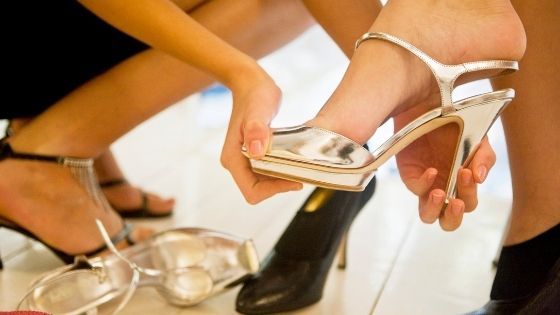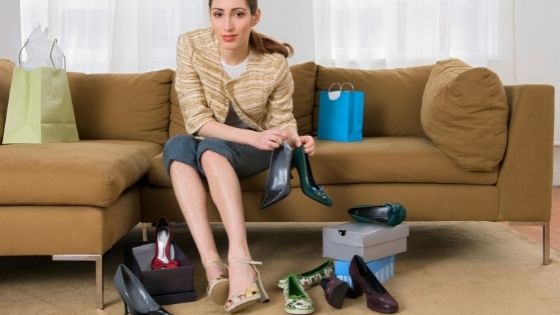How should a shoe fit? 10 Tips on How To Fit Your Shoes Properly!

How should a shoe fit? What size shoes do you wear? The best way to find out is by trying on a few different sizes. Of course, you want your toes to be able to wiggle comfortably, but not so much that they’re hanging off the front of the shoe.
Your heel should feel snug and secure without feeling like it’s slipping up and down in the back.
And if you have wide feet, make sure there’s enough room for your toes or bunions at the end. It can take some trial and error before you find a pair that feels just right!
We think every woman deserves shoes that fit her perfectly, whether she wears leather shoes, walking shoes, style, or budget!
Read this blog post now to get started finding your perfect fit today!
How do shoes fit?
Get your feet measured (one foot is usually larger than the other,) or wear a shoe fitting guide. Then, wear the shoes for when you have larger feet, and try socks while wearing them to see if they fit just right!
Try on both pairs of shoes - one at a time- to ensure that it fits correctly. You have to fit your pair of shoes to your larger foot.
Also, please pay attention to how well it rubs or pinches, as those often indicate that you need new-sized footwear!
What is a good fit?
Always remember to take your time when choosing a shoe size for formal occasions. For example, dress shoes should have at least a quarter-inch between the long toe and leather for a proper shoe fit. But this will depend on personal preference of style as well.
If you find that one-finger tests are needed, it can reveal whether or not you need to go up in sizes on either side (the larger or smaller).
For shoes with heels, always make sure that toes lie together, so they do not become cramped from wearing too high of a heel height—remember each person is different!
For more classy footwear choices for formal events, consider taking some extra time to choose which type would best suit their design preferences. Some people may prefer dressy styles while others like less conservative designs. Both types require quality
10 Tips on how to fit a shoe for the correct size

A good shoe should fit the shape of your foot and not vice versa. Poorly fitting shoes can cause foot problems, including corns and bunions.
The correct size in width and length will largely determine success with shoes. So, before going to a shoe store, we must consider these aspects:
Try on shoes on both feet.
Try shoes on both feet, as people's feet are different, and it is important to make sure the shoe fits properly. If there is any doubt, it is a good idea to measure your feet by a professional.
If the shoe fits correctly, it should be snug around the widest point of your foot (usually at the toes). It should feel like a firm handshake for both width and length. There should not be too much space between your longest toe and the front of the shoe.
If you can wiggle your toes or the shoe feels loose, the shoe is probably too big. It should not feel as snug as a handshake or overly tight on either side of your foot.
And if it doesn't look right? Don't buy! You cannot ignore your own comfort and appropriate fitting for shoes.
Try them on with a type of sock you usually wear
It is important to try on shoes with the type of socks or stockings you usually wear because if they don't fit correctly, it could be a painful experience.
If your shoe doesn't have enough room for thicker socks, then you may find that wearing thinner ones will make them too tight and create sore spots on your feet.
Alternatively, not trying them can also cause problems since some brands are made so tightly that when worn without any protection, such as an undershirt or sock underfoot. As a result, sores may form even from just standing in one place!
Try them on late in the day.
Keep in mind that your feet are heavier at the end of the day than in the morning, so they tend to be more swollen. Also, you have to try on shoes at the end of the day to avoid finding them too tight.
Check the distance from the toe.
Check that the length is correct. Ideally, for women, the longest toe should be 0.2 inches (0.5 cm) from the end of the toe cap. For men, this distance should be around 0.4 inches (1 cm.)
The width should also be checked, either at the widest point of your foot or where you feel most comfortable.
Test breaking on a carpeted surface. If you try them on hard surfaces such as tiled floors, you may not get an accurate sense of how your shoes will actually feel later. So instead, try breaking in your new shoes on a carpeted surface.
Make sure you have enough room for your toes.
To prevent stubbed toes, make sure the top of the toe cap is high enough that your toes can freely come to a stop before they hit it.
If you have wide feet, you may want to look for shoes with roomy toe boxes. If you have long toes, you should try on your shoes with a pair of heavy socks to make sure you don't go over the front end of the toe box.
Watch the width of your shoe.
Have your feet measured? When you notice marked bumps on either side of the shoe, it's a sign that it is too tight. Likewise, if you can pinch about 5 mm of skin when bending the foot, or there are folds in your toes, it's an indication that the shoe is too wide.
Examine the length and width
Keep in mind that the shoe size you choose depends on the combination of width and length. For example, if your legs are larger than average but your ankles are smaller, a smaller inseam will work better for you than ankle-length pants with a long rise.
The shoe size is a guideline, but the number may vary from one maker’s design to another.
You have to adjust your foot to the shoe.
Ensure that the part of your foot with the widest surface area secures to one of the areas with the widest surfaces on the shoe.
Please note that you may need to adjust your foot position inside the shoe, and you may feel tightness on the outer side of your foot. This is normal when you are getting accustomed to narrow footwear.
The pinkie finger should not be situated over the forefoot
Make sure that the little toe isn't squeezed when in a shoe because this is an indication of a narrow shoe.
The heel must be well seated.
Make sure that the heel of your foot sits comfortably on the back of your foot (heel counter) to prevent it from sliding forward.
A lot of people who have trouble with their shoes hurting wear the wrong size heel. If you are a heel, you can try on your shoes with and without a heel pad to see if you like that better since most people have more space in the toe box when wearing heels.
When you walk, you should be able to feel your foot being securely planted on the ground so you won't stub your toes on your new shoes.
How do running shoes fit?
Running is one of the purest and most popular forms of exercise. All runners need a pair of comfortable athletic shoes, which you can find at any runner’s favorite store. The best way to decide what size shoe you should buy? Read on!
1. Go to a Specialized Sports Shop
You have to go to a specialized sports store, where an expert will analyze your footprint and recommend the models of shoes from various brands that may be best for you.
2. You Need Comfortable Running Shoes
Don't wear running shoes for soccer, hiking, or paddle tennis as they have different needs. If you want to start running regularly, get special shoes that are comfortable and give good support. You have to run at least once a week in these shoes.
3. Think the Surface Where You Will Train
It is important to consider what the terrain is where you are going to train. Running on grass, mountain, asphalt, or concrete isn't the same.
4. Know your gait type and running style
There are three kinds of runners: pronators, supinators, and neutrals. Pronators have their feet turn inward when they run. Supinators have their foot turn outward. Neutrals don't change as supinators or pronators do.
5. Be aware of your body weight and the structure of your feet
The weight of your body and the structure of your feet can affect which type of shoes you buy. For example, if you weigh 143 lbs, you will probably do well with lightweight shoes with less cushioning, but if you are over 200 lbs, it is best to get a shoe with more cushioning.
6. Be aware of the budget you have
The first thing you should know is that being expensive doesn't always mean better. You will find some models of shoes that are more than $200, but those may not be the best for you. Likewise, don't buy cheap and flimsy shoes because they may not be comfortable.
7. Avoid making rookie mistakes
Avoid wearing shoes that are too heavy. They will only give you trouble, so choose to wear shoes lighter, weightier less than 300 or 400 grams.
If you wear the wrong size shoe, you can have health problems. First, make sure the front of your shoes has enough wiggle room for your toes. If you can't get your index finger in the shoe, it is probably too small. If they do not, then buy an extra size.
Conclusion
So, what should the perfect shoe feel like? The right fit is snug but not tight. You shouldn't be able to easily slide your fingers between the back of your heel and the inside of the shoe, nor have any extra space in front of your toes that could lead to blisters.
A good way to find out if you've found a well-fitting pair is when you take them off at night. They will naturally stretch with time and wear, so don't worry about buying too small or big shoes for this test!
